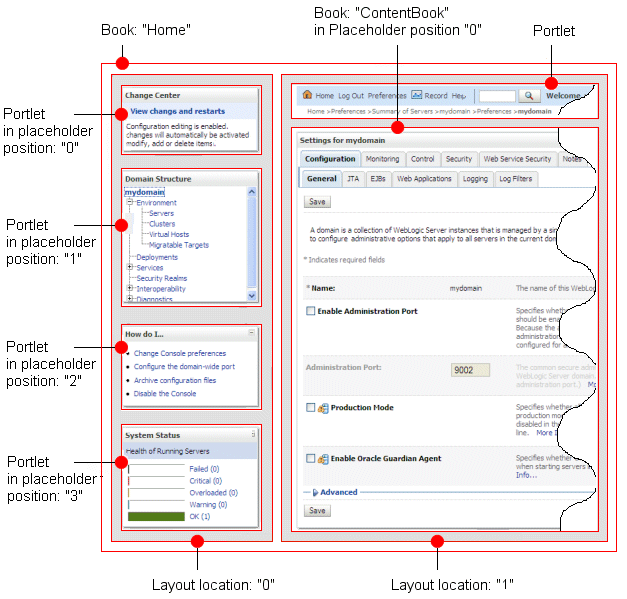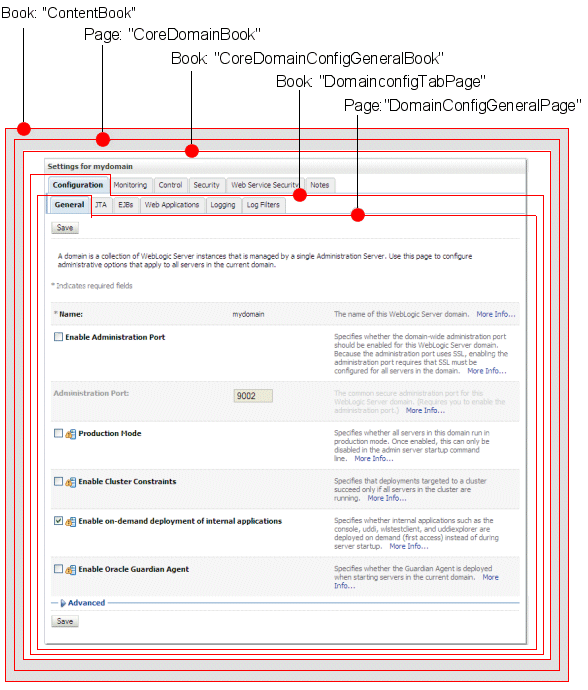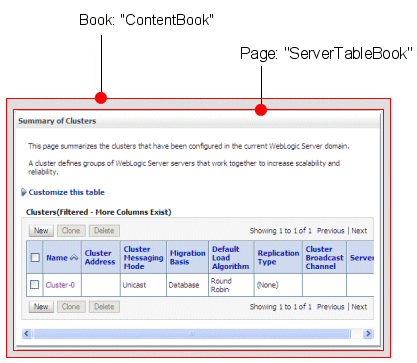2 Understanding Administration Console Extensions
The following sections describe Administration Console extensions:
What Is an Administration Console Extension?
An Administration Console extension is a WAR file that contains the resources for a section of a WebLogic Portal Web application. When you deploy the extension, the Administration Console creates an in-memory union of the files and directories in its WAR file with the files and directories in the extension WAR file. Once the extension has been deployed, it is a full member of the Administration Console: it is secured by the WebLogic Server security realm, it can navigate to other sections of the Administration Console, and if the extension modifies WebLogic Server resources, it participates in the change control process.
The simplest extension adds content to the Administration Console's home page (desktop). The WAR file for such an extension contains:
-
An Administration Console extension descriptor file, called
netuix-extension.xml, that describes the location in the UI in which you want your extension to display. -
An XML file that defines a WebLogic Portal portlet, which is a container for JSPs and other types of content.
-
A JSP file that contains the content you want to display.
The WAR file for more complex extensions can contain any of the following additional resources:
-
If the extension displays content in tabs within the Administration Console UI, the WAR contains XML files that describe other types of WebLogic Portal UI controls, such as tabs and subtabs (see Extension Points in the Administration Console).
-
If the extension uses Apache Struts to encapsulate business logic and navigation logic, the WAR file contains configuration files and Java classes for Apache Struts applications.
-
If the extension uses Apache Beehive to encapsulate business logic and navigation logic, the WAR file contains configuration files and Java classes for Apache Beehive applications.
-
Java classes, image files, or other types of resources that can be used in Java EE Web applications.
Note:
The Administration Console does not support WSRP portlets or portlets based on JSR 168.
How Do the WebLogic Portal Framework and WebLogic Portal Differ?
The WebLogic Portal framework provides basic support for rendering the UI. The full WebLogic Portal product provides the framework and additional features such as personalization, interaction management, content management, and the ability for end users to customize their portal desktops.
If you have WebLogic Server, then you can use the WebLogic Portal framework when creating Administration Console extensions. If you want your own Web applications to provide a portal interface, you can purchase the WebLogic Portal product.
Extension Points in the Administration Console
An extension point is a location in the Administration Console UI at which you can add or replace content. The UI for the Administration Console is rendered by groups of specialized WebLogic Portal components called UI controls. Each group of controls is responsible for rendering a specific part of the UI. For example, one group renders the two-column layout that you see after you log in to the Administration Console. Other groups render individual tabs in the tabbed interface.
The Administration Console attaches unique labels to many of its UI controls, and each labeled control is an extension point. You can also use these labels with WebLogic Server JSP tags to forward requests to specific UI controls. If a UI control is not identified by a label, you cannot extend it or forward to it. You must either interact with its labeled ancestor control or a labeled child control.
Hierarchy of UI Controls
UI controls for an application are defined in an XML file called a portal book file (.book file). The schema for this XML file specifies a hierarchy of UI controls, but some UI controls can be used at multiple levels in the hierarchy. The following list describes the types of UI controls that you will encounter most frequently while developing extensions (see Figure 2-1):
-
Desktop
The top level of the UI control hierarchy. It contains the Look and Feel for the Administration Console and the top-level book control.
-
Look and Feel
A collection of images, cascading style sheets, XML files, and other file types that control the appearance of a portal application.
-
Book
Aggregates a set of pages or other books. It can contain an optional menu control that provides navigation among its pages and books. Many books in the Administration Console use this menu control to render tabs, such as the domain's Configuration: General tab.
-
Page
Contains a layout, portlets, or books.
-
Layout
Defines a grid in the UI. Each column in the grid is called a placeholder, and each placeholder can host zero or more portlets or books.
Most pages in the Administration Console use a single column layout, but one of the top pages uses a two-column layout to create the left column that contains the Change Center, Domain Structure, and other portlets, and the right column that contains the tabbed interface.
-
Portlet
Defines static and dynamic content to display. You can add portlets to the Administration Console that contain JSP files or that forward to Struts
Actionsor Beehive Page Flows.
For information about the schema for UI controls, see Portal Support Schema Reference.
Note:
Figure 2-1 omits some intermediate controls in the hierarchy for the sake of brevity. For example, a book control does not directly contain a page control. Instead, a book contains a control named content, and the content control contains the page control.Figure 2-1 Subset of the UI Control Hierarchy
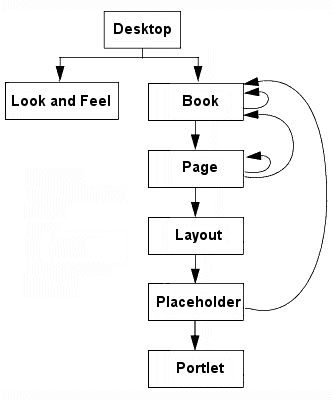
Description of "Figure 2-1 Subset of the UI Control Hierarchy"
The following sections describe the extension points in the Administration Console:
The Administration Console Desktop
Every WebLogic Portal Web application must have at least one desktop control, and the Administration Console supports only one. Its label is defaultDesktopLabel (see Figure 2-2).
Extending the Desktop
The only type of extension that is supported at this level of the Administration Console is a Look and Feel extension, which replaces Oracle's logos, colors, and fonts with yours. See Chapter 5, "Rebranding the Administration Console."
You cannot replace the Home book or add other controls to the desktop.
The Administration Console Look and Feel
The Look and Feel for the Administration Console defines the fonts and colors, Oracle logos, the layout of portal components, and the navigation menus.
Note:
Because the Administration Console uses only the WebLogic Portal Framework, it supports only a single Look and Feel. Portal applications that use the entire set of features available with the Oracle WebLogic Portal product can support multiple Look and Feels that are personalized based on user or group ID.Extending the Look and Feel
Creating a simple Look and Feel extension that contains your company's logos, fonts, and color scheme requires you to replace the logos and some cascading style sheet (CSS) definitions in a sample Look and Feel included in WebLogic Server. Making complex changes to the WebLogic Server Look and Feel, such as changing the layout of portal components and navigation menus, requires a more advanced knowledge of WebLogic Portal Look and Feels. If you have Oracle Workshop for WebLogic Platform 9.2 or later, you can use its Look and Feel editor to make these complex changes. For more information about Look and Feels, see "User Interface Development with Look & Feel Features" in Portal Development Guide for Oracle WebLogic Portal.
The Home Book and Page
The top-level book in the Administration Console is identified by the label Home. It contains a single page (labeled page) within which resides all of the Administration Console content (see Figure 2-3).
The page page uses a two-column layout. The left column (layout location 0) contains portlets that provide essential services when using the Administration Console. The right column (layout location 1) contains:
-
Portlets:
-
The topmost portlet displays a welcome message and contains buttons that launch online help and other services.
-
The second portlet displays breadcrumbs, which are a series of hypertext links that keep a history of your navigation in the Administration Console.
-
A third portlet is hidden by default and displays error messages and other status messages.
-
-
A book named
ContentBook. See The ContentBook.
Extending the Home Book
The simplest extensions within the Home book add portlets to either column of its page page. For example, below the System Status portlet, you can add a portlet that monitors your applications.
More complex extensions can append a book to the Home book. Such an extension causes the Home book and the extension book to display as two separate tabs.
The ContentBook
The ContentBook is a book that contains over 40 pages (see Figure 2-4), but it displays only one page at a time. Navigational controls throughout the Administration Console determine which page is displayed.
In Figure 2-4, a page named CoreDomainBook contains a book named CoreDomainConfigGeneralBook. The CoreDomainConfigGeneralBook contains six child books and a special UI control named singleLevelMenu that renders a tab for each child book (Configuration, Monitoring, Control, Security, WebService Security, and Notes). In turn, each child book (such as DomainconfigTabPage) contains several child page controls and the singleLevelMenu control. The Look and Feel causes the singleLevelMenu control to generate subtabs for the page controls at this level (General, JTA, EJBs, Web Applications, SNMP, Logging, and Log Filters).
Some content-specific books do not display a tabbed interface for their child books. Figure 2-5 shows the ServerBook, which does not display a tabbed interface.
Extending the ContentBook
The simplest extensions within the ContentBook add a child book to create a tab in a content-specific book or add a child page to create a subtab. See Define UI Controls (Optional).
Summary of the Administration Console UI Controls
Figure 2-6 shows the top levels of the Administration Console's labeled UI controls. To see all labeled UI controls, including all of the content-specific books, you can display all the console extension points in the Administration Console, as described in Configure Preferences to See UI Control Labels.
Figure 2-6 Summary of the UI Control Hierarchy
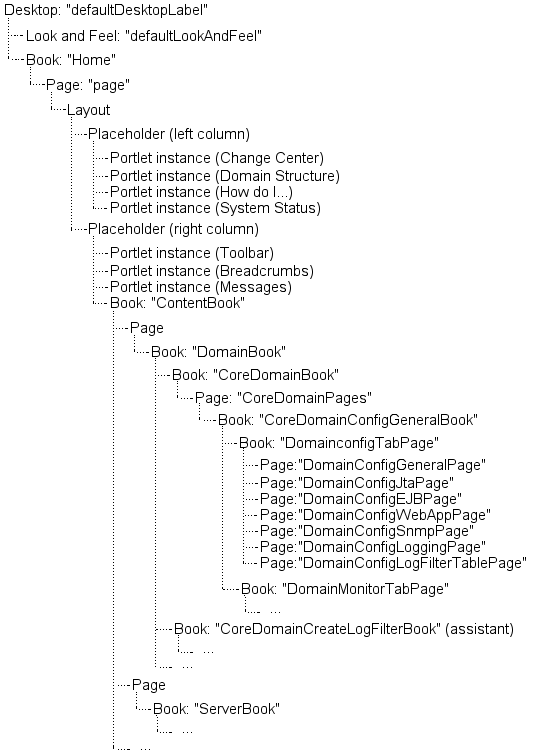
Description of "Figure 2-6 Summary of the UI Control Hierarchy"
JSP Templates and Tag Libraries
Oracle provides JSP templates and tag libraries that you can use to render such UI features as tables, data-entry boxes, and buttons. For information about the JSP templates, see WebLogic Server JSP Templates.
JSP Tag Libraries
The Administration Console provides its own tag library (console-html.tld) that you can use in your Administration Console extensions. It also provides runtime support for a group of standard, third-party tag libraries that the Administration Console itself uses.
To import these third-party JSP tag libraries into your JSPs, you must use pre-defined, absolute URIs. The Administration Console's web.xml file maps these URIs to tag libraries within the WebLogic Server installation. This mapping facility enables Oracle to reorganize its installation directory without requiring you to change your JSPs.
Table 2-1 lists the tag libraries for which the Administration Console provides runtime support and the URIs for importing them into your JSPs.
If you want development support for these libraries (for example, if you use an integrated development environment that provides code completion for JSP tags), you must configure your development environment to include these tags.
Note:
You can create custom tag libraries or use additional tag libraries, but you must include all of the necessary support files for custom tag libraries in your extension WAR file. See Programming JSP Tag Extensions for Oracle WebLogic Server.Table 2-1 Included JSP Tag Library Support
| Tag Library and URI | Description |
|---|---|
|
Tag library: URI: |
WebLogic Server JSP tags for creating HTML forms and tables that match the functionality of the forms and tables in the Administration Console. Use these tags only to extend the WebLogic Server Administration Console. The documentation for this tag library is in the Oracle WebLogic Server JSP Tags Reference. |
|
Tag library: URI: |
Convenience tag for generating a portal framework URL. See |
|
Tag library: URI: |
Apache Beehive JSP tags for associating JSPs with a JSP template. You can download the Beehive distribution, which includes the tag libraries and documentation from |
|
Tag library: URI: |
Apache Beehive JSP tags for binding data. You can download the Beehive distribution, which includes the tag libraries and documentation from |
|
Tag library: URI: |
Apache Beehive JSP tags for generating basic HTML tags. You can download the Beehive distribution, which includes the tag libraries and documentation from |
|
Tag library: URI: |
JavaServer Pages Standard Tag Library (JSTL) tags which provide core functionality common to many JSP applications. You can download the JSTL distribution from The documentation for these tag libraries is in the JSTL Tag Library Reference at |
|
Tag library: URI: |
JavaServer Pages Standard Tag Library (JSTL) tags which provide core functionality common to many JSP applications. You can download the JSTL distribution from The documentation for these tag libraries is in the JSTL Tag Library Reference at |
|
Tag library: URI: |
Apache Struts tags for interacting with the Struts framework. You can download the Struts distribution from The documentation for these tag libraries is available from |
|
Tag library: URI: |
Apache Struts tags for interacting with the Struts framework. You can download the Struts distribution from The documentation for these tag libraries is available from |
|
Tag library: URI: |
Apache Struts tags for interacting with the Struts framework. You can download the Struts distribution from The documentation for these tag libraries is available from |
|
Tag library: URI: |
Apache Struts tags for interacting with the Struts framework. You can download the Struts distribution from The documentation for these tag libraries is available from |
Example: How Struts Portlets Display Content
The following steps describe how the portal framework uses an extension's source files to find and display a Struts portlet as a tab in ContentBook:
-
The portal framework starts by parsing the extension's
netuix-extension.xmlfile.The
netuix-extension.xmlfile in this example specifies that the portal framework should load a.bookfile namedmedrecMonitor.bookand display its contents as a child of theCoreDomainConfigGeneralBookbook:<book-extension> <book-location> <parent-label-location label="CoreDomainConfigGeneralBook"/> <book-insertion-point action="append"/> </book-location> <book-content content-uri="/controls/medrecMonitor.book"/> </book-extension> -
The portal framework loads the
medrecMonitor.bookfile, which defines a page UI control and specifies that the page contains a portlet:<netuix:page markupName="page" markupType="Page"> ... <netuix:portletInstance markupType="Portlet" instanceLabel="medrecMonitor.Tab.Portlet" contentUri="/portlets/medrec_monitor_tab.portlet"/> </netuix:page> -
The portal framework loads the portlet file, which names a Struts
Actionto run:<portal:root> <netuix:portlet definitionLabel="MyPortlet" title="my.portlet.title"> <netuix:strutsContent module="/medrecMBean" action="MedRecMBeanFormAction" refreshAction="MedRecMBeanFormAction"/> </netuix:portlet> </portal:root>In the
netuix:strutsContentelement, themodule="/medrecMBean"attribute indicates that the definition for theMedRecMBeanFormActionStrutsActionis located in the Struts configuration file for the Struts module namedmedrecMBean. The Struts naming convention requires that this configuration file be namedstruts-auto-config-medrecMBean.xml. -
The portal framework hands control to the Struts controller servlet, which parses the
struts-auto-config-medrecMBean.xmlfile and finds the following definition for theMedRecMBeanFormAction:<action path="/MedRecMBeanFormAction" type="com.bea.medrec.extension.MedRecMBeanFormAction" name="medrecMBeanEJBForm" scope="request" validate="false"> <forward name="success" contextRelative="true" path="/ext_jsp/form_view.jsp"/> </action> -
When the Struts controller encounters the
name="medrecMBeanEJBForm"attribute of theactionelement, it looks in the same Struts configuration file for the definition of a form bean that is namedmedrecMBeanEJBForm.When it finds the following element in configuration file:
<form-bean name="medrecMBeanEJBForm" type="org.apache.struts.action.DynaActionForm"> <form-property name="name" type="java.lang.String"/> <form-property name="handle" type="com.bea.console.handles.Handle"/> <form-property name="totalRx" type="java.lang.Integer"/> </form-bean>it initializes a Java bean of type
org.apache.struts.action.DynaActionFormwith properties namedname,handle, andtotalRx. -
The Struts controller invokes the
com.bea.medrec.extension.MedRecMBeanFormActionclass and passes to this class theDynaActionFormbean that it instantiated. -
The
MedRecMBeanFormActionclass gathers data from an MBean in the MedRec application and populates the properties in theDynaActionFormbean with data from the MedRec MBean.The
MedRecMBeanFormActionclass returns the populatedDynaActionFormbean. -
The Struts controller serializes the
DynaActionFormbean, sets it in an HTTP request, and then forwards to a JSP. -
The JSP uses JSP tags to display data in the
DynaActionFormbean.
Figure 2-7 Overview of Loading a Struts Portlet
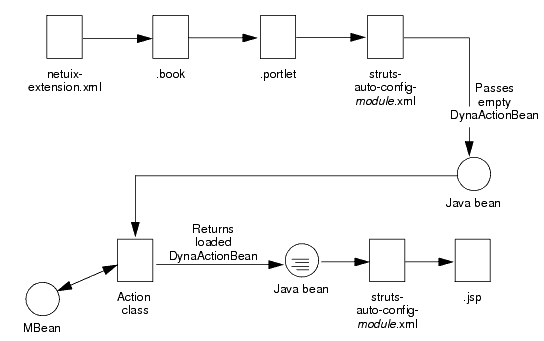
Description of "Figure 2-7 Overview of Loading a Struts Portlet"

